Social Wasps
Wasps (generally) have a less hairy body than bees. They don’t play much of a role in pollination; rather, they eat and parasitize other insects.
Social wasps nest communally and have only one fertile female: the queen. The nest is started by a queen that survived the winter. She produces sterile female workers, then these workers take over further construction, gathering food and tending to the many more workers being produced by the queen.
The pictures, below, show seven local species of social wasps:
 Bald-faced hornet (Dolichovespula maculata),
Bald-faced hornet (Dolichovespula maculata), Black jacket (Vespula consobrina),
Black jacket (Vespula consobrina), Western yellow jacket (Vespula pensylvanica),
Western yellow jacket (Vespula pensylvanica), Common yellow jacket (Vespula alascensis formally called Vespula vulgaris),
Common yellow jacket (Vespula alascensis formally called Vespula vulgaris), Forest yellow jacket (Vespula acadica),
Forest yellow jacket (Vespula acadica), Golden paper wasp (Polistes aurifer),
Golden paper wasp (Polistes aurifer), European paper wasp (Polistes dominula), invasive species here since 2007.
European paper wasp (Polistes dominula), invasive species here since 2007.The bald-faced hornet is black and white, stings readily, and builds large nearly spherical paper nests. The yellow jackets are a bit smaller, are black and yellow (sometimes white), sting readily, and build nests both in the ground and trees. Paper wasps are also black and yellow, but while they will sting, they are much slower to do so than the other wasps. They build open, single–layered, disc–shaped nests which enable easy observation of their activities.
This site also has a page about local solitary wasps.
Bald–faced hornet
Dolichovespula maculata
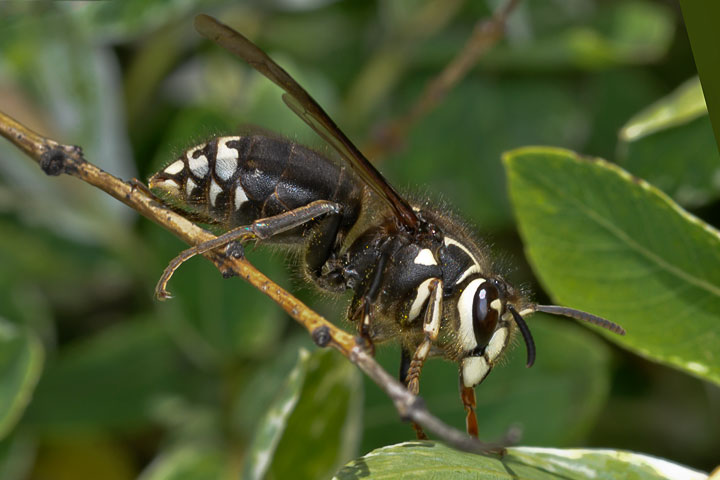 The bald–faced hornet (Dolichovespula maculata) is a type of yellowjacket which makes large paper nests.
The bald–faced hornet (Dolichovespula maculata) is a type of yellowjacket which makes large paper nests.
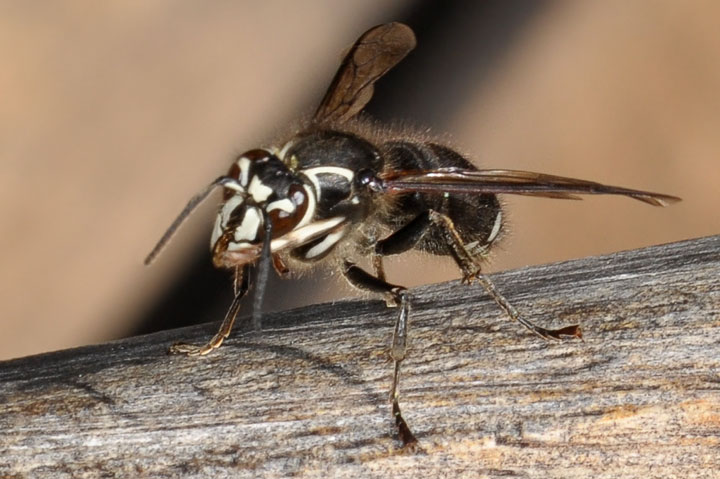 The bald–faced hornet harvests the wood fiber for its nests from many sources, including outdoor furniture, such as the back of this chair. It obtains its name from its white (i.e., bald) face. ID by RAC
The bald–faced hornet harvests the wood fiber for its nests from many sources, including outdoor furniture, such as the back of this chair. It obtains its name from its white (i.e., bald) face. ID by RAC
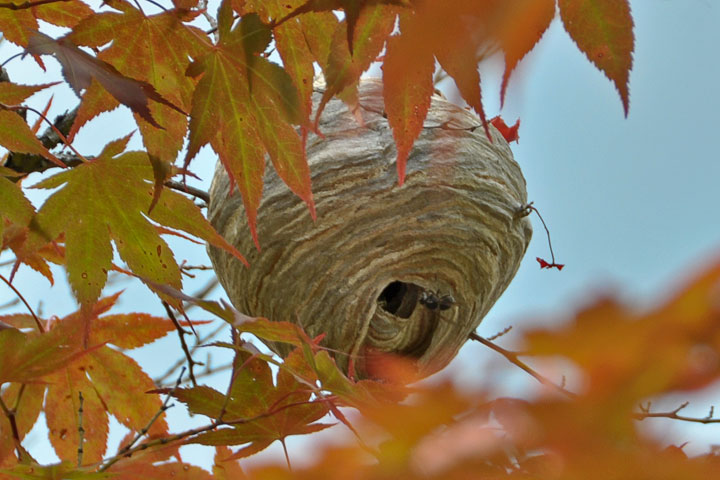 The nest of the bald–faced hornet is a roundish ball of a paperish substance created from chewed wood and saliva which is then spread by mandibles and legs and allowed to dry. The different shades reveal different sources of wood.
The nest of the bald–faced hornet is a roundish ball of a paperish substance created from chewed wood and saliva which is then spread by mandibles and legs and allowed to dry. The different shades reveal different sources of wood.
Black jacket
Vespula consobrina
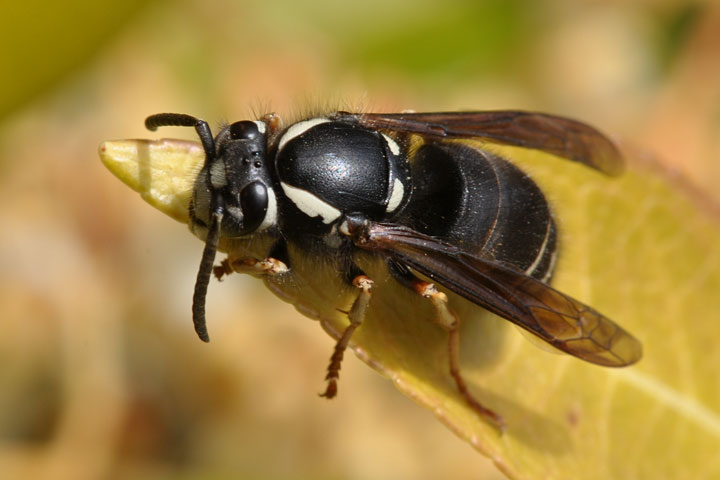 The black jacket Vespula consobrina is really a species of yellow jacket, but while it mimics the colours of the bald–faced hornet, it is quite a bit smaller. It differs in other ways, such as having a black spot on the face rather than a vertical line.
The black jacket Vespula consobrina is really a species of yellow jacket, but while it mimics the colours of the bald–faced hornet, it is quite a bit smaller. It differs in other ways, such as having a black spot on the face rather than a vertical line.
 It seems that the tongue of the black jacket is fairly short and so to obtain nectar from some flowers it bits its way through the side of a petal—a practice known as nectar robbing. The month, April, and the shape of the spot on its face suggests that this is a queen. ID by MB
It seems that the tongue of the black jacket is fairly short and so to obtain nectar from some flowers it bits its way through the side of a petal—a practice known as nectar robbing. The month, April, and the shape of the spot on its face suggests that this is a queen. ID by MB
Common yellow jacket
Vespula alascensis
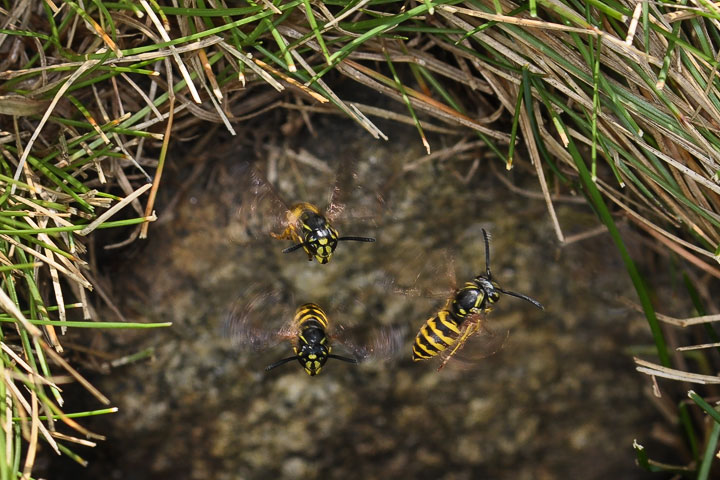 Common yellow jackets often nest in holes in the ground (such as abandoned rodent burrows) from which they emerge during the day to search for food.
Common yellow jackets often nest in holes in the ground (such as abandoned rodent burrows) from which they emerge during the day to search for food.
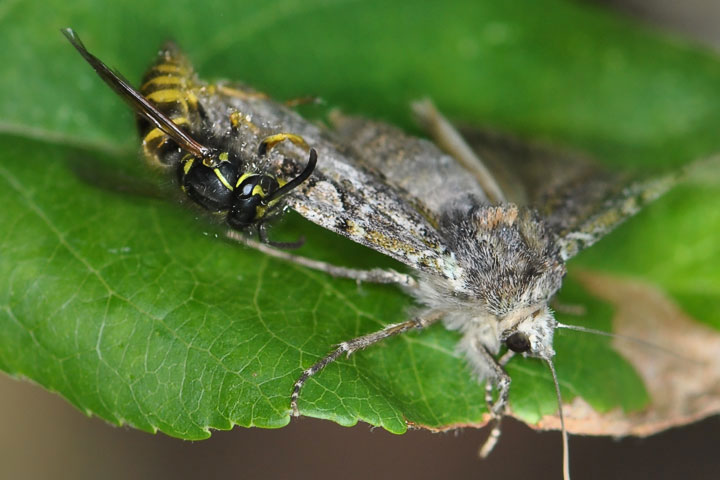 This common yellow jacket is subduing a wildly threshing moth by hanging onto its wing.
This common yellow jacket is subduing a wildly threshing moth by hanging onto its wing.
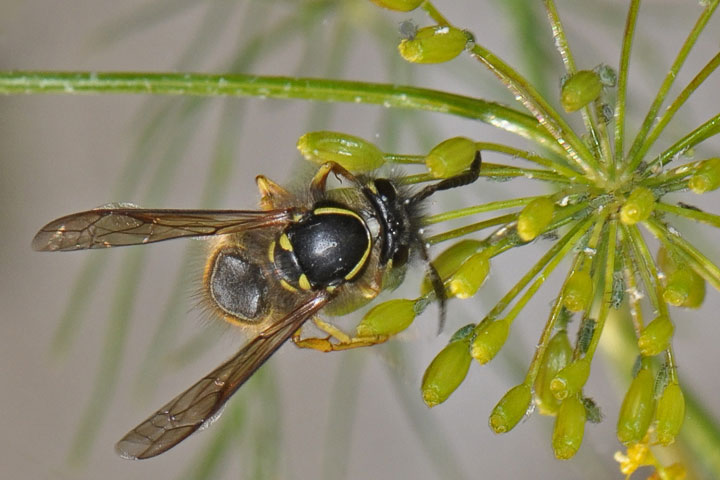 Yellow jackets like the honey dew made by aphids—a plentiful bug on this plant. Although uncertain, this is probably a common yellow jacket. ID by MB
Yellow jackets like the honey dew made by aphids—a plentiful bug on this plant. Although uncertain, this is probably a common yellow jacket. ID by MB
Western yellow jacket
Vespula pensylvanica
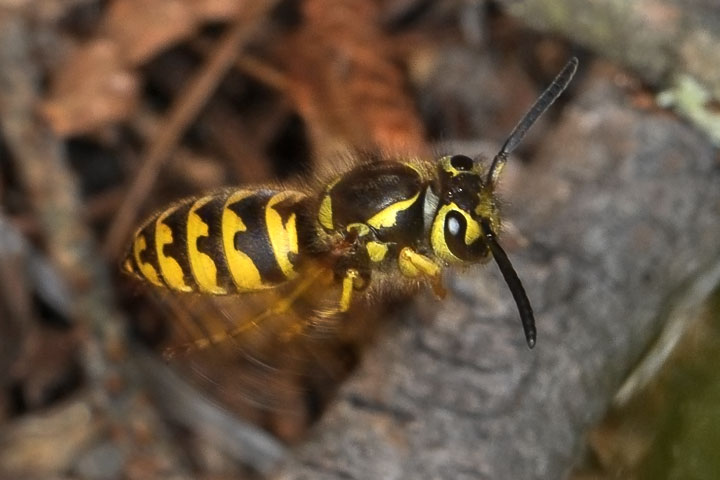 This western yellow jacket (Vespula pensylvanica) is patrolling the ground. On the western, the yellow wraps around the top of the eye, while on the common, it doesn’t. The has dark antennae has a bit of yellow on the first segment. ID by RAC
This western yellow jacket (Vespula pensylvanica) is patrolling the ground. On the western, the yellow wraps around the top of the eye, while on the common, it doesn’t. The has dark antennae has a bit of yellow on the first segment. ID by RAC

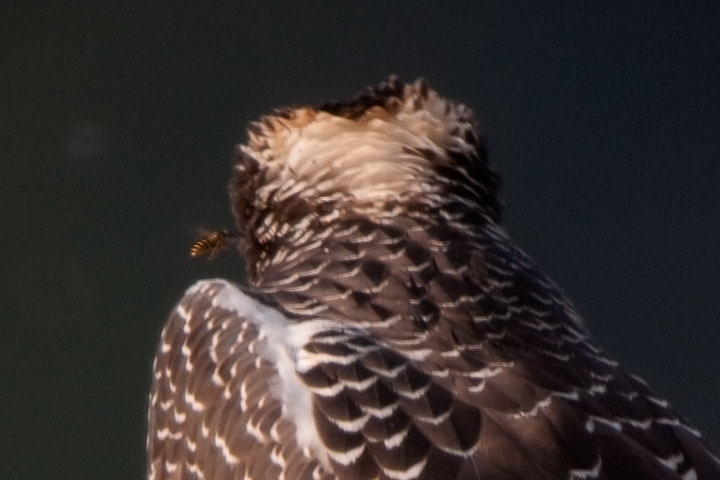 It is likely the smell of fish on the osprey that prompts the yellow jackets to take an interest.
It is likely the smell of fish on the osprey that prompts the yellow jackets to take an interest.
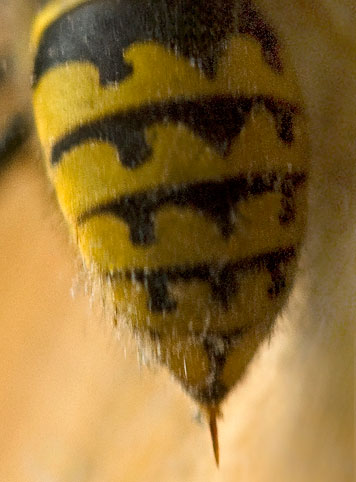 The stinger of the yellow jacket is lance-like (no barbs) and so can sting repeatedly.
The stinger of the yellow jacket is lance-like (no barbs) and so can sting repeatedly.
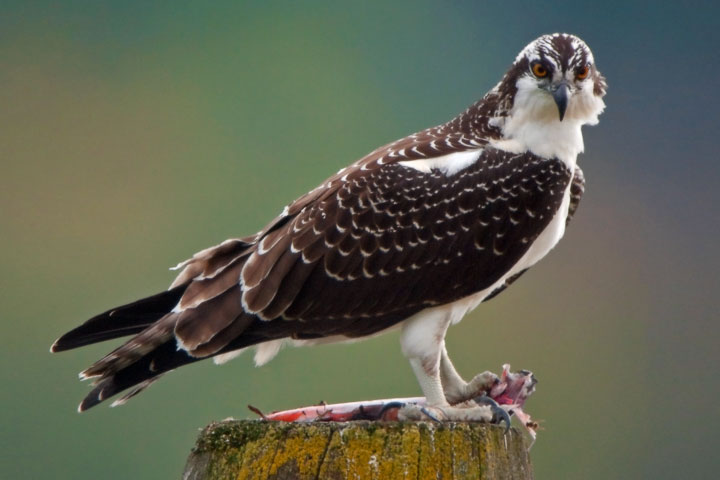 Yellow jackets like fish; ospreys catch fish. In the lower right, a yellow jacket is stealing some fish from the osprey. In these osprey pictures, the distance is too great to tell whether the wasps are western or common yellow jackets.
Yellow jackets like fish; ospreys catch fish. In the lower right, a yellow jacket is stealing some fish from the osprey. In these osprey pictures, the distance is too great to tell whether the wasps are western or common yellow jackets.
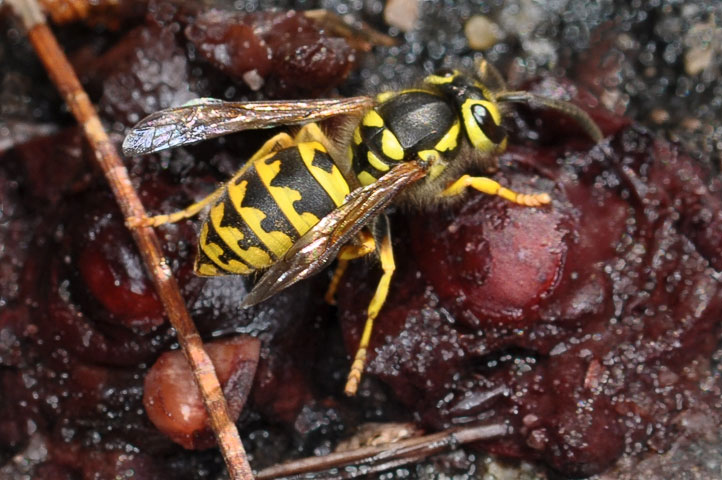 With fallen wild cherries all over the ground, the western yellow jacket (Vespula pensylvanica) is having a feast. ID by RAC
With fallen wild cherries all over the ground, the western yellow jacket (Vespula pensylvanica) is having a feast. ID by RAC
Forest yellow jacket
Vespula acadica
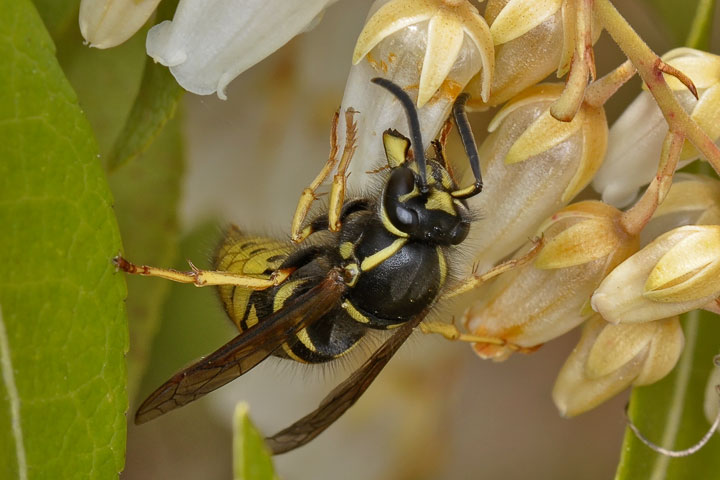 As its name suggests, the forest yellow jacket (Vespula acadica) is usually found in heavily forested areas—which certainly abound around the Lake. Colonies last for one year. Forest yellow jackets are usually predators of live prey—flies, caterpillars, hemipterans—but, this one is going after the nectar in a pieris japonica. This April picture almost certainly shows a queen. ID by MB
As its name suggests, the forest yellow jacket (Vespula acadica) is usually found in heavily forested areas—which certainly abound around the Lake. Colonies last for one year. Forest yellow jackets are usually predators of live prey—flies, caterpillars, hemipterans—but, this one is going after the nectar in a pieris japonica. This April picture almost certainly shows a queen. ID by MB
Golden paper wasp
Polistes aurifer
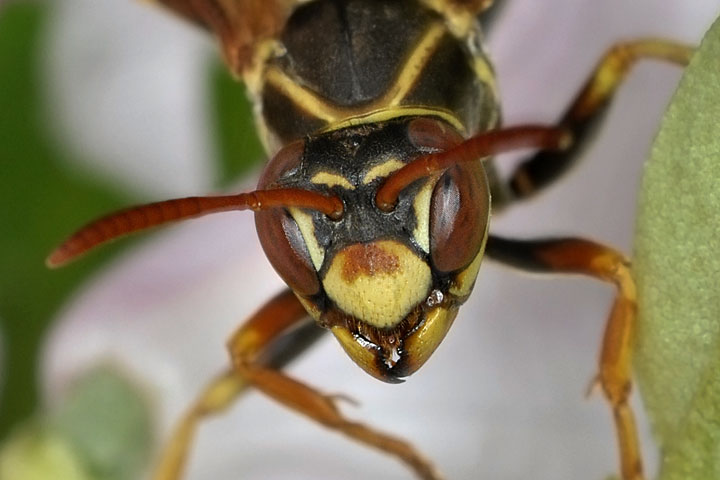 The indigenous species of paper wasp is the golden paper wasp (Polistes aurifer). It is both larger and distinctly more golden than the recently arrived, invasive species, the European paper wasp (below).
The indigenous species of paper wasp is the golden paper wasp (Polistes aurifer). It is both larger and distinctly more golden than the recently arrived, invasive species, the European paper wasp (below).
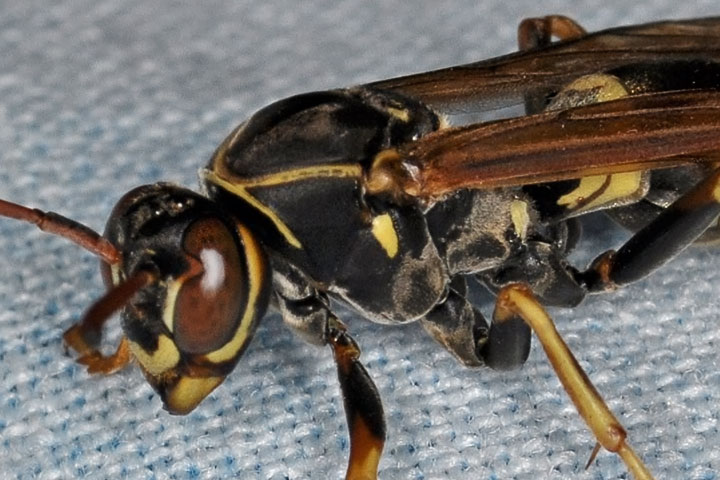 A golden paper wasp queen has come out on a warm January day to roam around a home—only queens overwinter in this way. ID by RAC
A golden paper wasp queen has come out on a warm January day to roam around a home—only queens overwinter in this way. ID by RAC
 Among the features which distinguish the region’s two species of paper wasp, are pale marks (eye spots) on the thorax: the golden lacks them; the European (below) has them.
Among the features which distinguish the region’s two species of paper wasp, are pale marks (eye spots) on the thorax: the golden lacks them; the European (below) has them.
European paper wasp
Polistes dominula
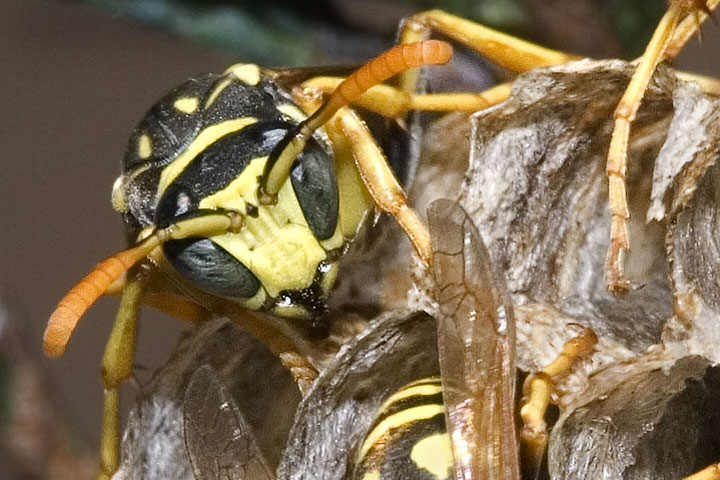 The European paper wasp (Polistes dominula) is smaller and more yellow than the native golden paper wasp. The European paper was is an invasive species first found in BC in 2003. The native species, above, (Polistes aurifer) is larger, has more brown and golden, is less markedly black and yellow and has fewer pale marks. ID by RAC
The European paper wasp (Polistes dominula) is smaller and more yellow than the native golden paper wasp. The European paper was is an invasive species first found in BC in 2003. The native species, above, (Polistes aurifer) is larger, has more brown and golden, is less markedly black and yellow and has fewer pale marks. ID by RAC
 A European paper wasp is patrolling the lawn.
A European paper wasp is patrolling the lawn.
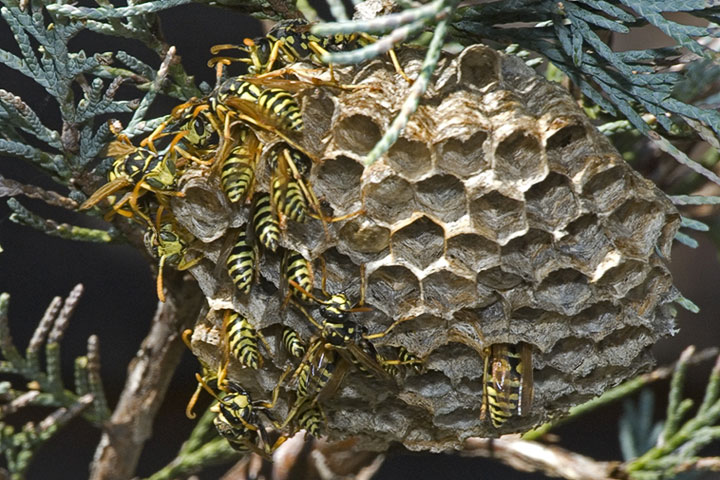 This is disc–shaped nest of the paper wasp.
This is disc–shaped nest of the paper wasp.
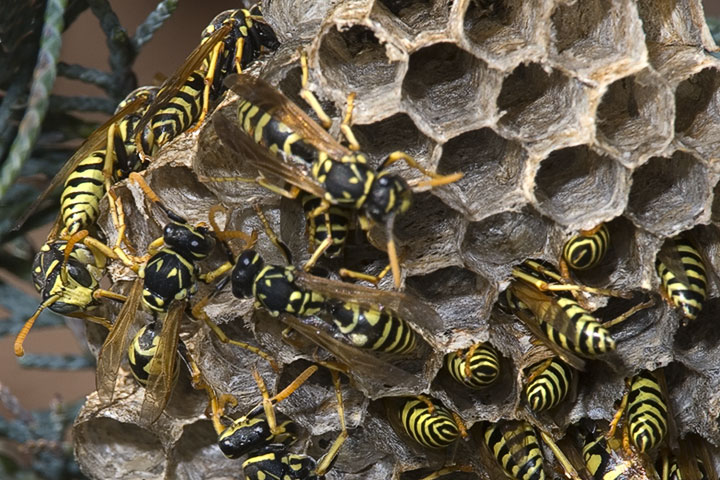 The paper wasp’s open nests, and usual lack of aggression, make the insects easy to observe.
The paper wasp’s open nests, and usual lack of aggression, make the insects easy to observe.
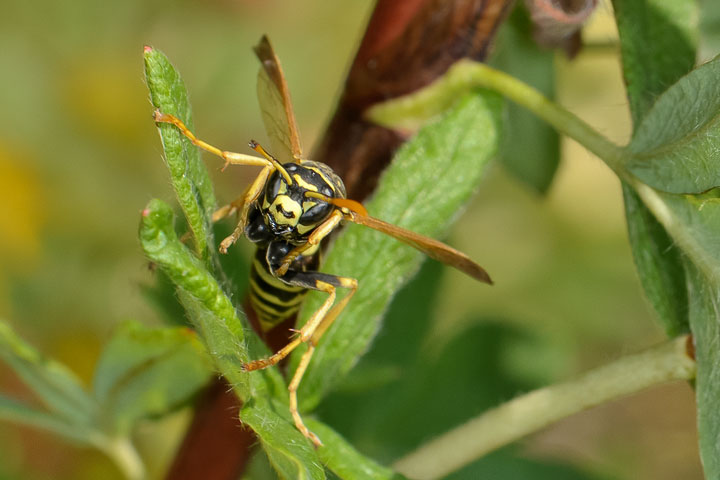 Staring at the camera and deciding if it is a threat.
Staring at the camera and deciding if it is a threat.
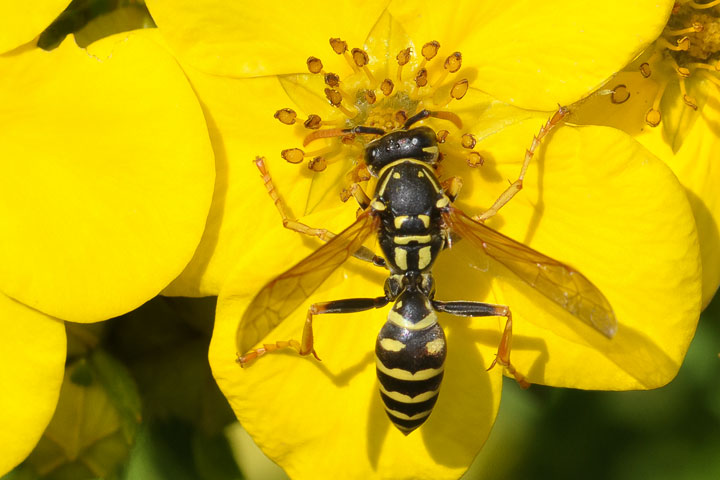 Collecting nectar at a cinquefoil bush.
Collecting nectar at a cinquefoil bush.
Identifications:
MB = Matthias Buck
RAC = Robert A Cannings
Information from Discover Life: Dolichovespula maculata, Vespula vulgaris (i.e., alascensis) ,
Vespula pensylvanica.
A paper about the arrival of the European paper wasp: …invasive European paper wasp in Canada.
![]()